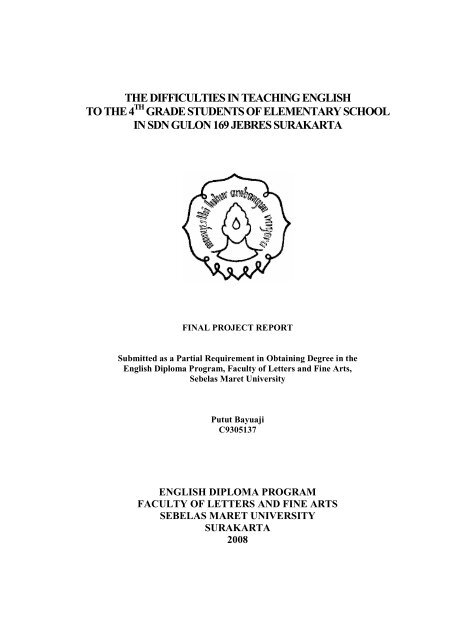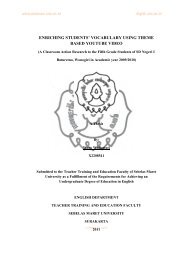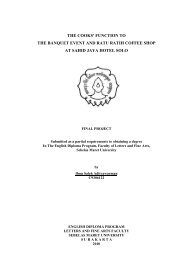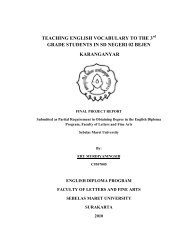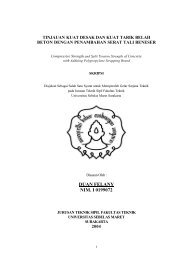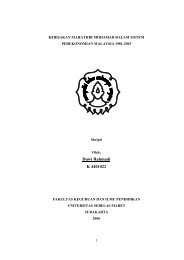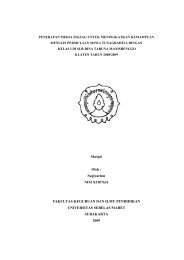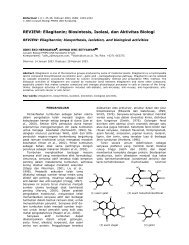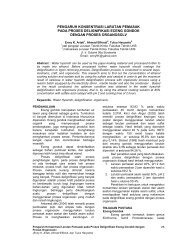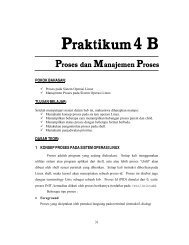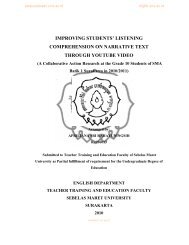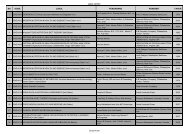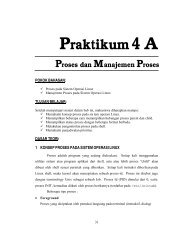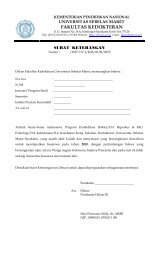grade students of elementary school in sdn gulon 169 jebres surakarta
grade students of elementary school in sdn gulon 169 jebres surakarta
grade students of elementary school in sdn gulon 169 jebres surakarta
You also want an ePaper? Increase the reach of your titles
YUMPU automatically turns print PDFs into web optimized ePapers that Google loves.
THE DIFFICULTIES IN TEACHING ENGLISH<br />
TO THE 4 TH GRADE STUDENTS OF ELEMENTARY SCHOOL<br />
IN SDN GULON <strong>169</strong> JEBRES SURAKARTA<br />
FINAL PROJECT REPORT<br />
Submitted as a Partial Requirement <strong>in</strong> Obta<strong>in</strong><strong>in</strong>g Degree <strong>in</strong> the<br />
English Diploma Program, Faculty <strong>of</strong> Letters and F<strong>in</strong>e Arts,<br />
Sebelas Maret University<br />
Putut Bayuaji<br />
C9305137<br />
ENGLISH DIPLOMA PROGRAM<br />
FACULTY OF LETTERS AND FINE ARTS<br />
SEBELAS MARET UNIVERSITY<br />
SURAKARTA<br />
2008
APPROVAL OF CONSULTANT<br />
Approved to be exam<strong>in</strong>ed before the Board <strong>of</strong> Exam<strong>in</strong>ers<br />
English Diploma Program, Faculty <strong>of</strong> Letters and F<strong>in</strong>e Arts<br />
Sebelas Maret University<br />
F<strong>in</strong>al Project Title:<br />
THE DIFFICULTIES IN TEACHING ENGLISH TO THE 4 TH GRADE<br />
STUDENTS OF ELEMENTARY SCHOOL IN SDN GULON <strong>169</strong> JEBRES,<br />
SURAKARTA<br />
Name<br />
NIM<br />
: Putut Bayuaji<br />
: C9305137<br />
Supervisor,<br />
Drs. Riyadi Santosa, M.Ed. ( …………………….. )<br />
NIP. 131569264<br />
ii
APPROVAL OF THE BOARD OF EXAMINERS<br />
Report Title : THE DIFFICULTIES IN TEACHING ENGLISH TO<br />
THE 4 TH GRADE STUDENTS OF ELEMENTARY<br />
SCHOOL IN SDN GULON <strong>169</strong> JEBRES, SURAKARTA<br />
Student’s Name : Putut Bayuaji<br />
NIM<br />
: C9305137<br />
Exam<strong>in</strong>ation Date : August 11, 2008<br />
Accepted and Approved by the Board <strong>of</strong> Exam<strong>in</strong>ers,<br />
English Diploma Program, Faculty <strong>of</strong> Letters and F<strong>in</strong>e Arts,<br />
Sebelas Maret University<br />
The Board <strong>of</strong> Exam<strong>in</strong>ers<br />
Yusuf Kurniawan, S.S., M.A.<br />
(…………………………)<br />
Chairperson NIP. 132231475<br />
M. Farchan Md., S.Ag. M.Ag. (…………………………)<br />
Secretary NIP. 132309950<br />
Drs. Riyadi Santosa, M.Ed.<br />
(…………………………)<br />
Ma<strong>in</strong> Exam<strong>in</strong>er NIP. 131569264<br />
Faculty <strong>of</strong> Letters and F<strong>in</strong>e Arts<br />
Sebelas Maret University<br />
Dean,<br />
Drs. Sudarno, MA<br />
NIP. 131 472 202<br />
iii
MOTTO<br />
To know wisdom and <strong>in</strong>struction; to perceive the words <strong>of</strong> understand<strong>in</strong>g;<br />
Proverbs 1:2<br />
By God, I can!<br />
Putut Bayuaji<br />
Sola Fide.<br />
iv
DEDICATION<br />
I would like to dedicate this f<strong>in</strong>al project to:<br />
v The Holy Tr<strong>in</strong>ity: Father, Son and Holy Spirit.<br />
v My beloved wife, M. Riyan Kristyanti.<br />
v My Mom and Dad, Mr. and Mrs. Mulyono.<br />
v Mr. and Mrs. Sukiyo, my new parents.<br />
v My brother and sisters, Angga, Elly and Tika.<br />
v
PREFACE<br />
Shallom,<br />
Praise and glory to the Lord, for His merciful grace. Due to his aid, the writer<br />
has been able to f<strong>in</strong>ish writ<strong>in</strong>g this f<strong>in</strong>al project report entitled “The Difficulties <strong>in</strong><br />
Teach<strong>in</strong>g English to the 4 th Grade Students <strong>of</strong> SDN Gulon, Jebres, Surakarta”.<br />
This f<strong>in</strong>al project is written by the writer to fulfill the requirement <strong>in</strong> obta<strong>in</strong><strong>in</strong>g<br />
the degree <strong>in</strong> English Diploma Program after f<strong>in</strong>ished the job tra<strong>in</strong><strong>in</strong>g activities <strong>in</strong><br />
SDN Gulon,Jebres, Surakarta. This report conta<strong>in</strong>s detailed <strong>in</strong>formation about the job<br />
tra<strong>in</strong><strong>in</strong>g activities, teach<strong>in</strong>g English to the <strong>students</strong>, the difficulties the writer had<br />
found, and the solutions to handle those problems.<br />
The writer would also like to express a great expression <strong>of</strong> thanks to everyone<br />
who gives their support and motivation dur<strong>in</strong>g the process accomplish<strong>in</strong>g this report.<br />
A great thanks is expressed to Drs. Riyadi Santosa, M.Ed., as his consultant, for the<br />
guidance and help <strong>in</strong> writ<strong>in</strong>g this f<strong>in</strong>al project. Also to Mr. Maryanto, S.Pd., MM. as<br />
his supervisor dur<strong>in</strong>g the job tra<strong>in</strong><strong>in</strong>g, for the opportunity and guidance.<br />
The writer realized that this f<strong>in</strong>al project report is far from be<strong>in</strong>g perfect.<br />
Therefore, any criticisms and advices are appreciated.<br />
However, the writer hopes that this f<strong>in</strong>al project report will be useful for all<br />
readers.<br />
vi
ACKNOWLEDGEMENTS<br />
Praise to the Lord, due to His bless<strong>in</strong>gs and guidance, I can complete this f<strong>in</strong>al<br />
project report. However, this f<strong>in</strong>al project would not be as it is now without the<br />
assistance and help from many <strong>in</strong>stitutions and <strong>in</strong>dividuals. Therefore, I would like to<br />
express my deepest thanks to:<br />
1. Drs. Sudarno, MA., as the Dean <strong>of</strong> Faculty <strong>of</strong> Letters and F<strong>in</strong>e Arts, Sebelas<br />
Maret University.<br />
2. Yusuf Kurniawan, SS.,MA., as the Chief <strong>of</strong> English Diploma Program.<br />
3. M. Farkhan M. S.Ag., M.Ag., my academic supervisor. Thank you for your<br />
advice and shar<strong>in</strong>g dur<strong>in</strong>g my study <strong>in</strong> English Diploma Program.<br />
4. Drs. Riyadi Santosa, M.Ed., as my supervisor <strong>in</strong> this f<strong>in</strong>al project. Thank you<br />
for all your time, guidance, and correction.<br />
5. All lectures <strong>in</strong> English Diploma Program, many thanks for all the knowledge you<br />
have shared and the guidance you have given.<br />
6. Maryanto, S.Pd. MM., the headmaster <strong>of</strong> SDN Gulon, Jebres, Surakarta for the<br />
permission and opportunity to have the job tra<strong>in</strong><strong>in</strong>g.<br />
7. All the Teachers <strong>in</strong> SDN Gulon, for all the joy and advice to be a better teacher.<br />
8. Students <strong>of</strong> SDN Gulon, for your smile and lesson to me.<br />
9. My beloved parents, thank you for your love, support, care, guidance and<br />
wisdom.<br />
10. My beloved wife, Margarita Riyan K., thank you.. You’re my sunsh<strong>in</strong>e after the<br />
ra<strong>in</strong>. I love you..<br />
vii
11. My brother and sisters, Angga, Elly and Tika. You are the colors <strong>of</strong> my live.<br />
12. My fellow compatriot, class C <strong>of</strong> 2005. Ratih, Fuji, Novie, Haryadi, da’ Big4,<br />
Trio Histeria, Kipli, Kampret, “adik Tata kecil”, Vika, Woro, Epik, Jiehan-yem,<br />
Rei, et.al. Well done everyone.. “SEMANGAT!”<br />
13. Park<strong>in</strong>g Community. Pak Dar, thank you for the conversations.<br />
14. All the staffs <strong>of</strong> English Diploma, Mbak Heni, Mas BG, thank you. What would<br />
I be without you..<br />
15. SLC Staffs. Mbak Rita, thank you for your assistance. Devi, go get “rabi”soon..<br />
16. To all people that I can not mention here, thank you very much. God bless us all.<br />
Surakarta, August 2008<br />
Putut Bayuaji<br />
viii
ABSTRACT<br />
Putut Bayuaji, 2008. The Difficulties <strong>in</strong> Teach<strong>in</strong>g English to the 4 th Grade<br />
Students <strong>of</strong> Elementary School <strong>in</strong> Sdn Gulon <strong>169</strong> Jebres, Surakarta. English<br />
Diploma Program, Faculty <strong>of</strong> Letters and F<strong>in</strong>e Arts, Sebelas Maret University.<br />
This f<strong>in</strong>al project has the purpose to identify the difficulties <strong>in</strong> teach<strong>in</strong>g English to the<br />
4 th <strong>grade</strong> <strong>students</strong> based on the job tra<strong>in</strong><strong>in</strong>g that had been done by the writer <strong>in</strong> SDN<br />
Gulon, Jebres, Surakarta. The difficulties were related to teach<strong>in</strong>g and learn<strong>in</strong>g<br />
processes which have been faced by both the <strong>students</strong> and the writer himself.<br />
The writer use grammar translation method to deliver the material <strong>of</strong> the lesson to the<br />
<strong>students</strong>. The activities used dur<strong>in</strong>g the lesson were prepared to develop <strong>students</strong>’<br />
skills <strong>in</strong> read<strong>in</strong>g, listen<strong>in</strong>g, speak<strong>in</strong>g, and writ<strong>in</strong>g. Occasionally, the writer used<br />
pictures and games to help the <strong>students</strong> understand better about the materials given.<br />
Dur<strong>in</strong>g the job tra<strong>in</strong><strong>in</strong>g, the writer found many difficulties <strong>in</strong> develop<strong>in</strong>g the <strong>students</strong>’<br />
skills and <strong>in</strong> deliver<strong>in</strong>g the material. These problems were divided <strong>in</strong>to two<br />
categories, l<strong>in</strong>guistic problem and non-l<strong>in</strong>guistic problems. Different pronunciation<br />
between English with Indonesian became the problem <strong>of</strong> l<strong>in</strong>guistics. While <strong>in</strong> nonl<strong>in</strong>guistic<br />
problem, the ma<strong>in</strong> issues were class management, limited time <strong>of</strong> teach<strong>in</strong>g,<br />
<strong>students</strong>’ motivation <strong>in</strong> learn<strong>in</strong>g English and the lack <strong>of</strong> ELT facilities. In this f<strong>in</strong>al<br />
project report, the writer also provides solutions to handle those problems. To<br />
overcome l<strong>in</strong>guistic problem, cont<strong>in</strong>uous practice could help the <strong>students</strong>. Creat<strong>in</strong>g<br />
good class management, manag<strong>in</strong>g time to teach, motivat<strong>in</strong>g <strong>students</strong>’ to learn<br />
English through fun and effective learn<strong>in</strong>g, and provid<strong>in</strong>g aid and ELT facilities could<br />
help the writer and <strong>students</strong>’ to overcome non-l<strong>in</strong>guistic problems. Moreover, a good<br />
cooperation with the class teacher would help more.<br />
ix
TABLE OF CONTENTS<br />
pages<br />
TITLE …………………………………………………………………………<br />
APPROVAL OF CONSULTANT ……………………………………………<br />
i<br />
ii<br />
APPROVAL OF THE BOARD OF EXAMINERS …………………………….. iii<br />
MOTTO ……………………………………………………………………….<br />
DEDICATION ………………………………………………………………..<br />
PREFACE ……………………………………………………………………..<br />
ACKNOWLEDGEMENTS …………………………………………………...<br />
ABSTRACT …………………………………………………………………...<br />
TABLE OF CONTENTS ………………………………………………………<br />
TABLE OF DIAGRAM ………………………………………………………..<br />
iv<br />
v<br />
vi<br />
vii<br />
ix<br />
x<br />
xii<br />
CHAPTER I: INTRODUCTION …………………………………………… 1<br />
A. Background ………………. ……………………………… 1<br />
B. Objectives ………………………………………………… 3<br />
C. Benefits …………………………………………………… 3<br />
CHAPTER II: LITERATURE REVIEW …………………………………….. 5<br />
A. Teach<strong>in</strong>g and Learn<strong>in</strong>g …………………………………… 5<br />
1. Teach<strong>in</strong>g Def<strong>in</strong>itions ………………………………….. 5<br />
2. Teach<strong>in</strong>g Methods …………………………………….. 6<br />
3. Learn<strong>in</strong>g……………………………………………..… 10<br />
B. Teach<strong>in</strong>g English to Young Learners ……………………. 10<br />
x
CHAPTER III: DISCUSSION ……………………………………………….. 14<br />
A. Description <strong>of</strong> SD N Gulon, Jebres, Surakarta …………. 14<br />
1. Description and Brief History <strong>of</strong> SD N Gulon .……... 14<br />
2. School Structural Organization ……………….…….. 15<br />
3. Extracurricular Activities ………………………….... 16<br />
B. Job Tra<strong>in</strong><strong>in</strong>g ………………………………………...…… 16<br />
1. Class Observation ……………………………….…... 16<br />
2. Lesson Plan and Material Preparation ………….…… 18<br />
3. Teach<strong>in</strong>g and Learn<strong>in</strong>g Activities ……………..……. 18<br />
C. Discussion ………………………………………………. 20<br />
1. Teach<strong>in</strong>g English to the 4 th Grade Students …..…….. 20<br />
2. Difficulties <strong>in</strong> Teach<strong>in</strong>g English to 4 th Grade Students 23<br />
3. The Solutions to Handle the Problems …………….... 26<br />
CHAPTER IV: CONCLUSION AND SUGGESTION ……………………… 29<br />
A. Conclusions ……………………………………………… 29<br />
B. Suggestions ……………………………………………… 32<br />
BIBLIOGRAPHY<br />
APPENDICES<br />
xi
TABLE OF DIAGRAM<br />
Diagram 1. School Structural Organization …………………………………… 15<br />
xii
1<br />
CHAPTER I<br />
INTRODUCTION<br />
A. Background<br />
S<strong>in</strong>ce the day it was first used, language has become an important aspect <strong>of</strong><br />
life. We use language <strong>in</strong> all parts <strong>of</strong> our life. We need to communicate with others<br />
s<strong>in</strong>ce day one <strong>of</strong> our life. Parents teach us with the first language we know as mother<br />
tongue. Then we learn another language, Bahasa Indonesia, our national language at<br />
<strong>school</strong>.<br />
Today, as the world moves to the age <strong>of</strong> globalization, the need <strong>of</strong> learn<strong>in</strong>g<br />
other language, especially English is <strong>in</strong>creas<strong>in</strong>g and important. English is one <strong>of</strong> the<br />
languages used as an <strong>in</strong>ternational language <strong>in</strong> many countries, <strong>in</strong>clud<strong>in</strong>g Indonesia.<br />
By learn<strong>in</strong>g English, many benefits will follow; one <strong>of</strong> them is <strong>in</strong>formation and<br />
technology transfer from abroad vice versa. By that reason, the government<br />
encourages Elementary <strong>school</strong>s <strong>in</strong> Indonesia to teach English to their <strong>students</strong>,<br />
although English is not <strong>in</strong>cluded <strong>in</strong> national curriculum. As we know, <strong>elementary</strong><br />
<strong>school</strong> is the first level for children to learn formally. English, as a part <strong>of</strong> <strong>school</strong><br />
local curriculum is taught start<strong>in</strong>g from 4 th <strong>grade</strong> up to 6 th <strong>grade</strong>.<br />
At present, our country needs a lot <strong>of</strong> Indonesian human resources who master<br />
English well. Thus, the English diploma Program, Faculty <strong>of</strong> Letters and F<strong>in</strong>e Arts <strong>in</strong><br />
Sebelas Maret University, after equipp<strong>in</strong>g their <strong>students</strong> with theories and skills,<br />
requires them to conduct job tra<strong>in</strong><strong>in</strong>g, practic<strong>in</strong>g their knowledge by apply<strong>in</strong>g them <strong>in</strong><br />
xiii
the real situation. That is one <strong>of</strong> the efforts done by the Program to get graduates to<br />
meet relevance with the needs <strong>in</strong> the society.<br />
The writer as one <strong>of</strong> the English Diploma Program <strong>students</strong> held the job<br />
tra<strong>in</strong><strong>in</strong>g as an English teacher <strong>in</strong> the Elementary School at SDN Gulon <strong>169</strong>, Jebres,<br />
Surakarta. The writer taught English to the 4 th <strong>grade</strong> up to 6 th <strong>grade</strong> <strong>students</strong>. Dur<strong>in</strong>g<br />
the job tra<strong>in</strong><strong>in</strong>g, the writer concerned the material given to the <strong>students</strong>, the<br />
difficulties and problems <strong>in</strong> teach<strong>in</strong>g and learn<strong>in</strong>g process and the solutions to handle<br />
the problems.<br />
The material given has to be appropriate with the <strong>elementary</strong> <strong>students</strong> based<br />
on the curriculum (KTSP) and to meet with the standard from National Education<br />
Standardization Board (BSNP). Dur<strong>in</strong>g the job tra<strong>in</strong><strong>in</strong>g as an English teacher, the<br />
writer focused on the 4 th <strong>grade</strong> <strong>students</strong> <strong>of</strong> <strong>elementary</strong> <strong>school</strong>. The reason why the<br />
writer focused <strong>in</strong> 4 th <strong>grade</strong> <strong>students</strong> <strong>of</strong> <strong>elementary</strong> <strong>school</strong> because <strong>in</strong> this <strong>grade</strong> the<br />
<strong>students</strong> were <strong>in</strong>troduced to English as a new language lesson beside their mother<br />
tongue, the Javanese language and Bahasa Indonesia as their national language. By<br />
learn<strong>in</strong>g English, the <strong>students</strong> were <strong>in</strong>troduced with someth<strong>in</strong>g entirely new and<br />
different from th<strong>in</strong>gs they used to know.<br />
Teach<strong>in</strong>g English to young learners can be very excit<strong>in</strong>g as well as frustrat<strong>in</strong>g.<br />
They are very active, always want to know the new th<strong>in</strong>gs, ask th<strong>in</strong>gs they do not<br />
understand around them, <strong>in</strong>clud<strong>in</strong>g English as a new language they learn. They are<br />
also very moody and easily get bored with the situation and can be annoy<strong>in</strong>g.<br />
However, <strong>in</strong> teach<strong>in</strong>g English to the 4 th <strong>students</strong> <strong>of</strong> <strong>elementary</strong> <strong>school</strong> the writers<br />
found some difficulties and problems. Two ma<strong>in</strong> problems faced by the writers were<br />
xiv
mak<strong>in</strong>g the <strong>students</strong> understand to the material given and handl<strong>in</strong>g the attitude <strong>of</strong> the<br />
<strong>students</strong> dur<strong>in</strong>g the lessons. The writer arranged a lesson plan for each session which<br />
<strong>in</strong>cludes activities to get the <strong>students</strong> attentions. The activities were <strong>in</strong>tended to<br />
deliver the material to the <strong>students</strong> us<strong>in</strong>g real objects, illustration or pictures; games<br />
and giv<strong>in</strong>g po<strong>in</strong>ts to the <strong>students</strong> who are active dur<strong>in</strong>g the lesson as a bonus. The<br />
problems faced by the <strong>students</strong> <strong>in</strong> learn<strong>in</strong>g English were the lack <strong>of</strong> ELT sources; this<br />
problem holds up the teach<strong>in</strong>g learn<strong>in</strong>g process. The <strong>students</strong> only have a workbook<br />
entitled LINTAS as their ma<strong>in</strong> source <strong>of</strong> learn<strong>in</strong>g English. Without sufficient ELT<br />
facilities, the writer, and <strong>students</strong> found difficulties <strong>in</strong> teach<strong>in</strong>g and learn<strong>in</strong>g English.<br />
Therefore, based on the job tra<strong>in</strong><strong>in</strong>g, the topic <strong>of</strong> this f<strong>in</strong>al project is about the<br />
difficulties and problems <strong>in</strong> teach<strong>in</strong>g English to the 4 th <strong>grade</strong> <strong>of</strong> <strong>elementary</strong> <strong>school</strong><br />
<strong>students</strong> and the way to overcome the problems. This f<strong>in</strong>al project report is entitled<br />
“The Difficulties <strong>in</strong> Teach<strong>in</strong>g English to the 4 th Grade Students <strong>of</strong> Elementary<br />
School <strong>in</strong> SDN Gulon <strong>169</strong>, Jebres, Surakarta.”<br />
B. Objectives<br />
Based on the background above, the objectives <strong>of</strong> this report are:<br />
1. To f<strong>in</strong>d out what difficulties faced by the English teacher <strong>in</strong> teach<strong>in</strong>g English to<br />
the 4 th <strong>grade</strong> <strong>students</strong> <strong>of</strong> SDN Gulon, Jebres, Surakarta are.<br />
2. To f<strong>in</strong>d out what difficulties faced by the <strong>students</strong> <strong>of</strong> 4 th <strong>grade</strong> <strong>of</strong> SDN Gulon,<br />
Jebres, Surakarta <strong>in</strong> learn<strong>in</strong>g English.<br />
3. To present the solutions to both the teacher and <strong>students</strong> <strong>of</strong> SDN Gulon, Jebres,<br />
Surakarta to overcome the difficulties <strong>in</strong> learn<strong>in</strong>g English.<br />
xv
C. Benefits<br />
It is hoped that this f<strong>in</strong>al project report would be useful for:<br />
1. Elementary <strong>school</strong> English teachers<br />
This report is expected to be able to help teachers <strong>in</strong> improv<strong>in</strong>g the way to teach<br />
English <strong>in</strong> the Elementary <strong>school</strong>.<br />
2. Elementary <strong>school</strong> <strong>students</strong><br />
This report can be used to help <strong>students</strong> <strong>in</strong> learn<strong>in</strong>g English <strong>in</strong> a better way.<br />
3. The readers<br />
The writer hopes that this f<strong>in</strong>al project can be used as an additional reference for<br />
the readers who are <strong>in</strong>terested <strong>in</strong> teach<strong>in</strong>g and learn<strong>in</strong>g English <strong>in</strong> Elementary<br />
<strong>school</strong>.<br />
xvi
5<br />
CHAPTER II<br />
LITERATURE REVIEW<br />
In this chapter, the writer will present at least three ma<strong>in</strong> topics related to the<br />
title <strong>of</strong> this f<strong>in</strong>al project. Those three topics are teach<strong>in</strong>g, English as a foreign<br />
language, and young learners. All <strong>of</strong> the topics will be reviewed <strong>in</strong> more detailed<br />
below.<br />
A. Teach<strong>in</strong>g and Learn<strong>in</strong>g<br />
1. Teach<strong>in</strong>g Def<strong>in</strong>itions<br />
In order to learn a new knowledge and how to do a new practice, we all<br />
need help from other people who know better than we are; we need them to make<br />
us understand. This def<strong>in</strong>ition is given by Douglas Brown, “Teach<strong>in</strong>g may be<br />
def<strong>in</strong>ed as show<strong>in</strong>g or help<strong>in</strong>g someone to learn how to do someth<strong>in</strong>g, provid<strong>in</strong>g<br />
with knowledge, caus<strong>in</strong>g to know or understand”. (Brown, 2001: 7).<br />
Similar def<strong>in</strong>ition was also given by Kenneth D. Moore, “Teach<strong>in</strong>g is the<br />
action <strong>of</strong> someone who is try<strong>in</strong>g to assist others to reach their fullest potential <strong>in</strong><br />
all aspects <strong>of</strong> development”. (Moore, 1998: 20). This means <strong>in</strong> teach<strong>in</strong>g activities,<br />
teachers are responsible to teach and to guide their <strong>students</strong> <strong>in</strong> learn<strong>in</strong>g process<br />
and to fulfill the goal <strong>of</strong> learn<strong>in</strong>g itself.<br />
Furthermore, to be a good teacher is not as easy and as simple can<br />
imag<strong>in</strong>e, there are some issues that a teacher should have, they are:<br />
a. A teacher should make his lesson <strong>in</strong>terest<strong>in</strong>g.<br />
xvii
. A teacher should love his job.<br />
c. A teacher should have lots <strong>of</strong> knowledge<br />
d. A teacher is an enterta<strong>in</strong>er <strong>in</strong> a positive sense, not <strong>in</strong> a negative sense.<br />
(Harmer, 1998: 1, 2)<br />
From the def<strong>in</strong>itions above we can conclude that teach<strong>in</strong>g is a process <strong>of</strong><br />
help<strong>in</strong>g and guid<strong>in</strong>g <strong>students</strong> by provid<strong>in</strong>g knowledge to develop the student’s<br />
potential to their highest po<strong>in</strong>t.<br />
2. Teach<strong>in</strong>g Methods<br />
H. Douglas Brown <strong>in</strong> his book entitled Teach<strong>in</strong>g by Pr<strong>in</strong>ciples, an<br />
Interactive Approach to Language Pedagogy (2001: 51) def<strong>in</strong>e method as a<br />
generalized set <strong>of</strong> classroom specifications for accomplish<strong>in</strong>g l<strong>in</strong>guistic<br />
objectives. Furthermore, accord<strong>in</strong>g to Brown (2001: 52–57) there are 6 methods<br />
can be applied <strong>in</strong> teach<strong>in</strong>g language, they are:<br />
a. Grammar Translation Method<br />
Also known as Classical Method before the 19 th century, accord<strong>in</strong>g to<br />
Brown, the Grammar Translation Method “focuses on grammatical rules,<br />
memorization <strong>of</strong> vocabulary and <strong>of</strong> various declensions and conjugations,<br />
translations <strong>of</strong> text, do<strong>in</strong>g written exercises” (Brown, 2001: 52). In this<br />
method, more attention is given to vocabulary and grammar than other.<br />
The major characteristics <strong>of</strong> grammar translation method are:<br />
i. Classes are taught <strong>in</strong> the mother tongue, with little active use <strong>of</strong> the<br />
target language.<br />
ii.<br />
Much vocabulary is taught <strong>in</strong> the form <strong>of</strong> lists <strong>of</strong> isolated words.<br />
xviii
iii.<br />
iv.<br />
Long elaborate explanations <strong>of</strong> the <strong>in</strong>tricacies <strong>of</strong> grammar are given.<br />
Grammar provides the rules for putt<strong>in</strong>g the words together, and<br />
<strong>in</strong>struction <strong>of</strong>ten focuses on the form and <strong>in</strong>flection <strong>of</strong> words.<br />
v. Read<strong>in</strong>g <strong>of</strong> difficult classical texts is begun early.<br />
vi.<br />
Little attention is paid to the content <strong>of</strong> texts, which are treated as<br />
exercises <strong>in</strong> grammatical analysis.<br />
vii. Often the only drills are exercises <strong>in</strong> translat<strong>in</strong>g disconnected sentences<br />
from the target language <strong>in</strong>to the mother tongue.<br />
viii. Little or no attention is given to pronunciation.<br />
(Brown, 2001: 53)<br />
b. Gou<strong>in</strong> and the Series Method<br />
Accord<strong>in</strong>g to Gou<strong>in</strong> <strong>in</strong> Brown language learn<strong>in</strong>g is primarily a matter<br />
<strong>of</strong> transform<strong>in</strong>g perceptions <strong>in</strong>to conceptions. Language is a means <strong>of</strong><br />
th<strong>in</strong>k<strong>in</strong>g, <strong>of</strong> represent<strong>in</strong>g the world to oneself. By that reason, the Series<br />
Method was created: a method that taught learners directly (without<br />
translation) and conceptually (without grammatical rules and explanations) a<br />
“series” <strong>of</strong> connected sentences that are easy to perceive.<br />
c. The Direct Method<br />
Hav<strong>in</strong>g similarity with the Gou<strong>in</strong> methods, namely, that second<br />
language learn<strong>in</strong>g should be more like first language learn<strong>in</strong>g – lots <strong>of</strong> oral<br />
<strong>in</strong>teraction, spontaneous use <strong>of</strong> the language, no translation between first and<br />
second language, and little or no analysis <strong>of</strong> grammatical rules(Brown,<br />
xix
2001:55). Richards and Rodgers (1986: 9-10) <strong>in</strong> Brown summarize the<br />
pr<strong>in</strong>ciples <strong>of</strong> the Direct Method as follow:<br />
i. Classroom <strong>in</strong>struction was conducted exclusively <strong>in</strong> the target language.<br />
ii.<br />
iii.<br />
Only everyday vocabulary and sentences were taught.<br />
Oral communication skills were built up <strong>in</strong> a carefully traded<br />
progression organized around question-and-answer exchanges between<br />
teachers and <strong>students</strong> <strong>in</strong> small, <strong>in</strong>tensive class.<br />
iv.<br />
Grammar was taught <strong>in</strong>ductively.<br />
v. New teach<strong>in</strong>g po<strong>in</strong>ts were taught through model<strong>in</strong>g and practice.<br />
vi.<br />
Concrete vocabulary was taught through demonstration, objects, and<br />
pictures; abstracts vocabulary was taught by association <strong>of</strong> ideas.<br />
vii. Both speech and listen<strong>in</strong>g comprehension were taught.<br />
viii. Correct pronunciation and grammar were emphasized.<br />
Brown, 2001: 55–56)<br />
d. The Audiol<strong>in</strong>gual Method<br />
Colloquially known as the “Army Method”, the Audiol<strong>in</strong>gual Method<br />
ma<strong>in</strong> characteristic was a great deal <strong>of</strong> oral activity – pronunciation and<br />
pattern drills and conversation practice – with virtually none <strong>of</strong> the grammar<br />
and translation found <strong>in</strong> traditional classes. Brown def<strong>in</strong>ed this method as<br />
“The method that focused on the aural/oral skills”. (Brown, 2001: 57).<br />
The characteristic <strong>of</strong> the Audiol<strong>in</strong>gual Method from Prator and Celce-<br />
Murcia <strong>in</strong> Brown (2001) are:<br />
i. New material is presented <strong>in</strong> dialog form.<br />
xx
ii.<br />
There is dependence on mimicry, memorization <strong>of</strong> set phrases, and<br />
overlearn<strong>in</strong>g.<br />
iii.<br />
Structures are sequenced by means <strong>of</strong> contrastive analysis and taught<br />
one at a time.<br />
iv.<br />
Structural patterns are taught us<strong>in</strong>g repetitive drills.<br />
v. There is little or no grammatical explanation. Grammar is taught by<br />
<strong>in</strong>ductive analogy rather than deductive explanation.<br />
vi.<br />
Vocabulary is strictly limited and learned <strong>in</strong> context.<br />
vii. There is much use <strong>of</strong> tapes, language labs, and visual aids.<br />
viii. Great importance is attached to pronunciation.<br />
ix.<br />
Very little use <strong>of</strong> the mother tongue by teachers is permitted.<br />
x. Successful <strong>of</strong> response are immediately re<strong>in</strong>forced.<br />
xi.<br />
There is a great effort to get <strong>students</strong> to produce error-free utterances.<br />
xii. There is a tendency to manipulate language and disregard content.<br />
Brown, 2001: 57)<br />
e. “Designer” Methods <strong>of</strong> the Spirited Seventies<br />
“Designer method <strong>in</strong>corporates certa<strong>in</strong> elements <strong>of</strong> there<strong>of</strong> <strong>in</strong> our<br />
current communicative, <strong>in</strong>teractive, eclectic approach to language teach<strong>in</strong>g”<br />
(Brown, 2001: 58). Those certa<strong>in</strong> elements are <strong>in</strong>tended as the five products <strong>of</strong><br />
the spirited seventies, they are: community language learn<strong>in</strong>g, suggestopedia,<br />
the silent way, total physical response and the natural approach. In language<br />
teach<strong>in</strong>g us<strong>in</strong>g this method, a teacher is responsible to choose the best <strong>of</strong> what<br />
xxi
others have experimented with and adapt those <strong>in</strong>sights (elements) to his<br />
situation.<br />
f. Beyond Method: Notional-Functional Syllabuses<br />
Popularly known as the Notional-Functional Syllabuses method, “The<br />
dist<strong>in</strong>guish<strong>in</strong>g characteristics <strong>of</strong> the Notional-Functional Syllabuses (NFS)<br />
were its attention to function as the organiz<strong>in</strong>g elements <strong>of</strong> English language<br />
curriculum, and its contrast with a structural syllabus <strong>in</strong> which sequenced<br />
grammatical structures served as the organizers” (Brown, 2001: 67). Brown<br />
also stated that this method is not a method at all, but it’s a syllabus. It means<br />
this method comb<strong>in</strong>es and organizes the elements <strong>in</strong> the English curriculum,<br />
so the application <strong>of</strong> this method will be appropriate with the language we<br />
use.<br />
3. Learn<strong>in</strong>g<br />
Learn<strong>in</strong>g is always def<strong>in</strong>ed as a change <strong>of</strong> an <strong>in</strong>dividual as a result <strong>of</strong><br />
experience. This changes are comes <strong>in</strong> many forms, both <strong>in</strong> nature and k<strong>in</strong>ds.<br />
Therefore, those changes <strong>in</strong> an <strong>in</strong>dividual are a change <strong>in</strong> means <strong>of</strong> learn<strong>in</strong>g.<br />
Douglas Brown also gives a def<strong>in</strong>ition; “Learn<strong>in</strong>g is acquir<strong>in</strong>g or gett<strong>in</strong>g<br />
<strong>of</strong> knowledge <strong>of</strong> subject or a skill by study, experience, or <strong>in</strong>stitution”. (Brown,<br />
2001: 7). This statement by Brown shows that learn<strong>in</strong>g is not only by study<strong>in</strong>g but<br />
also by experienc<strong>in</strong>g someth<strong>in</strong>g personally or <strong>in</strong> an <strong>in</strong>stitution.<br />
Similar to Brown, accord<strong>in</strong>g to Oemar Hamalik, “Learn<strong>in</strong>g is a process <strong>of</strong><br />
behavioral changes as a result <strong>of</strong> experience and tra<strong>in</strong><strong>in</strong>g”. (Hamalik, 1989: 60).<br />
While Harold Spears <strong>in</strong> Sardiman AM stated, “Learn<strong>in</strong>g is to observe, to read, to<br />
xxii
imitate, to try someth<strong>in</strong>g themselves, to listen, to follow direction”. (Sardiman,<br />
1986: 22). Spears is not only shows the def<strong>in</strong>ition but also the process <strong>of</strong> learn<strong>in</strong>g<br />
itself. This process, shown by Spears, helps teachers how to conduct teach<strong>in</strong>g and<br />
learn<strong>in</strong>g process based on student’s learn<strong>in</strong>g style.<br />
Thus, <strong>in</strong> this learn<strong>in</strong>g process, we will f<strong>in</strong>d cooperative activities between<br />
teacher and <strong>students</strong>, as stated by Jeremy Harmer, “Learn<strong>in</strong>g is a partnership<br />
between teachers and <strong>students</strong>”<br />
Based on def<strong>in</strong>itions above, we can conclude that learn<strong>in</strong>g is a process to<br />
learn and experience new knowledge resulted <strong>in</strong> changes <strong>of</strong> behavior before and<br />
after the learn<strong>in</strong>g process.<br />
B. Teach<strong>in</strong>g English to Young Learners<br />
Teach<strong>in</strong>g English as a second language is completely different from teach<strong>in</strong>g<br />
the same material to adult. “To be able to teach children, teachers must understand<br />
them”. (Petersen and Hayden, 1961: 44). Each child is different and unique. In the<br />
classroom, teacher had to face them and teaches them new knowledge and skills. This<br />
is not an easy task to do. As stated by Brown, “Teach<strong>in</strong>g beg<strong>in</strong>ners is considered by<br />
many as the most challeng<strong>in</strong>g level <strong>of</strong> language <strong>in</strong>struction”. (Brown, 2001: 101).<br />
Furthermore, Brown also stated that children with their fluency and naturalness are<br />
<strong>of</strong>ten the envy <strong>of</strong> adults struggl<strong>in</strong>g with second languages, children <strong>in</strong> classrooms<br />
may have some difficulties learn<strong>in</strong>g a second language. Brown underl<strong>in</strong>ed the word<br />
“classrooms” to differ from children who learn second language from other sources,<br />
such as family or parents.<br />
xxiii
Moreover, <strong>in</strong> his book entitled The Practice <strong>of</strong> Language Teach<strong>in</strong>g, Jeremy<br />
Harmer stated that, “More than anyth<strong>in</strong>g else, children are curious, and this <strong>in</strong> itself is<br />
motivat<strong>in</strong>g. At the same time their span <strong>of</strong> attention or concentration is less than that<br />
<strong>of</strong> an adult”. (Harmer, 1991: 7). Children are very active, they will not go<strong>in</strong>g just to<br />
sit and listen to the teachers explanation. “Children need more frequent changes <strong>of</strong><br />
activities”. (Harmer, 1991: 7). It means that children need activities that is excit<strong>in</strong>g<br />
and stimulates their curiosity. To handle this problem, Brown set five practical<br />
approaches to teach<strong>in</strong>g children (Brown, 2001: 91 – 93). They are:<br />
1. Intellectual development<br />
Up to the age <strong>of</strong> eleven children are at the stage called “concrete operations”. In<br />
this stage, children have limitation <strong>in</strong> rules, explanations and abstract talk.<br />
Children are centered “here and now” on the functional purposes <strong>of</strong> language.<br />
2. Attention Span<br />
Language lessons can be difficult for children; the teacher’s task is to make them<br />
<strong>in</strong>terest<strong>in</strong>g, lively, and fun. The focus is still “here and now” us<strong>in</strong>g variety <strong>of</strong><br />
activities and animated subject. A good sense <strong>of</strong> humor <strong>of</strong> the teacher can trigger<br />
the children’s curiosity and ma<strong>in</strong>ta<strong>in</strong> their attention and focus.<br />
3. Sensory Input<br />
Children need to have all five senses stimulated; activities should strive to go well<br />
beyond the visual and auditory modes.<br />
4. Affective Factors<br />
xxiv
Children are <strong>of</strong>ten <strong>in</strong>novative <strong>in</strong> language forms but still have a great many<br />
<strong>in</strong>hibitions. Teachers need to help them to overcome such potential barriers to<br />
learn<strong>in</strong>g.<br />
5. Authentic, Mean<strong>in</strong>gful Language<br />
Children are focused on what this new language can actually be used for right<br />
here and now. They are less will<strong>in</strong>g to put up with language that doesn’t hold<br />
immediate rewards for them.<br />
xxv
14<br />
CHAPTER III<br />
DISCUSSION<br />
In this chapter, the writer will focus on writ<strong>in</strong>g the activities done dur<strong>in</strong>g the<br />
job tra<strong>in</strong><strong>in</strong>g divided <strong>in</strong>to three sub-chapters; cover<strong>in</strong>g the <strong>school</strong> and class description,<br />
job tra<strong>in</strong><strong>in</strong>g activities, and discussion about the activities on job tra<strong>in</strong><strong>in</strong>g.<br />
A. Description <strong>of</strong> SD N Gulon, Jebres, Surakarta<br />
1. Description and Brief History <strong>of</strong> SD N Gulon, Jebres, Surakarta<br />
Located <strong>in</strong> Jl. Sejahtera RT o2/XIX Gulon, Jebres, Surakarta, SD N Gulon<br />
is one <strong>of</strong> the state owned <strong>elementary</strong> public <strong>school</strong>s. Established on June 16 th<br />
1978, s<strong>in</strong>ce then eleven headmasters had lead the <strong>school</strong>. The recent headmaster<br />
is Mr. Maryanto, S.Pd., M.M. have been runn<strong>in</strong>g the <strong>school</strong> s<strong>in</strong>ce mid-2006.<br />
The <strong>school</strong> occupies an area <strong>of</strong> 1763 m 2 with 768 m 2 <strong>of</strong> it is used for<br />
build<strong>in</strong>gs, 680 m 2 for yard, and the rest 225 m 2 for the <strong>school</strong> garden. The <strong>school</strong><br />
has 6 rooms for 1 st <strong>grade</strong> to 6 th <strong>grade</strong> teach<strong>in</strong>g-learn<strong>in</strong>g activities, one religion<br />
room for Christians, one danc<strong>in</strong>g room, one headmaster room, one teachers room,<br />
one library, a mushola, five bathrooms, a kitchen, one health unit room, one<br />
computer room, two park<strong>in</strong>g area, a canteen, and a storeroom.<br />
SD N Gulon, Jebres, Surakarta has twelve teachers, six teachers are<br />
classroom teachers. Each teacher handles a class and teaches almost all subjects to<br />
their <strong>students</strong>. Other teachers are responsible for teach<strong>in</strong>g particular subjects, such<br />
as sports, danc<strong>in</strong>g, religions, and English despite other adm<strong>in</strong>istration job.<br />
xxvi
SD N Gulon, Jebres, Surakarta <strong>students</strong> <strong>in</strong> total are 243 <strong>students</strong>, 145 <strong>of</strong><br />
them are boys and the other 98 <strong>students</strong> are girls. Most <strong>of</strong> the <strong>students</strong> are from<br />
the kampungs near the <strong>school</strong>. The teach<strong>in</strong>g and learn<strong>in</strong>g process <strong>in</strong> SD N Gulon,<br />
Jebres, Surakarta is held six days a week, beg<strong>in</strong>n<strong>in</strong>g at 07.00 am to 12.45 pm <strong>in</strong><br />
Mondays to Thursday, and 07.00 am to 10.45 am <strong>in</strong> Fridays and Saturdays.<br />
2. School Structural Organization<br />
The headmaster is the leader <strong>in</strong> the <strong>school</strong>; responsible for all related with<br />
the <strong>school</strong> activities, teach<strong>in</strong>g-learn<strong>in</strong>g process and adm<strong>in</strong>istration. To do his job,<br />
the headmaster is assisted with the <strong>school</strong> secretary and the treasurers. The<br />
secretary is responsible for the <strong>school</strong> adm<strong>in</strong>istrations. The treasurers are<br />
responsible for the <strong>school</strong> f<strong>in</strong>ance management. There are six classroom teachers,<br />
who are responsible for the learn<strong>in</strong>g-teach<strong>in</strong>g <strong>of</strong> general subjects, and also class<br />
management and adm<strong>in</strong>istration.<br />
There are also teachers who are responsible for particular subjects and a<br />
librarian that manag<strong>in</strong>g the library and documentation. All <strong>of</strong> them are<br />
responsible directly to the headmaster. Follow<strong>in</strong>g is the diagram that describes<br />
The Organization Structure <strong>of</strong> SD N Gulon, Jebres, Surakarta.<br />
Headmaster<br />
Secretary<br />
xxvii<br />
Treasurer<br />
1 st <strong>grade</strong><br />
Teacher<br />
2 nd <strong>grade</strong><br />
Teacher<br />
3 rd <strong>grade</strong><br />
Teacher<br />
4 th <strong>grade</strong><br />
Teacher<br />
5 th <strong>grade</strong><br />
Teacher<br />
6 th <strong>grade</strong><br />
Teacher
Structrural l<strong>in</strong>es<br />
Coord<strong>in</strong>ation l<strong>in</strong>es<br />
3. Extracurricular Activities<br />
There are two active extracurricular activities <strong>in</strong> SD N Gulon, Jebres,<br />
Surakarta, they are:<br />
a. March<strong>in</strong>g Band “TakKusangka”, practice every Tuesday, for 4 th and 5 th <strong>grade</strong><br />
<strong>students</strong>.<br />
b. Boy Scout, practice every Friday afternoon for 3 rd to 6 th <strong>grade</strong> <strong>students</strong>.<br />
Besides, there are eventual extracurricular activities for the <strong>students</strong>, such<br />
as draw<strong>in</strong>g and rebana.<br />
B. Job Tra<strong>in</strong><strong>in</strong>g<br />
1. Class Observation<br />
In his job tra<strong>in</strong><strong>in</strong>g, the writer made an observation to the situation and<br />
condition <strong>of</strong> the <strong>school</strong>. This observation <strong>in</strong>cludes the facilities, teach<strong>in</strong>g activities<br />
by the classroom teacher and about the <strong>students</strong>. The aim <strong>of</strong> this observation is to<br />
xxviii
know any <strong>in</strong>formation needed about the <strong>school</strong> and the class, which was used by<br />
the writer to help teach<strong>in</strong>g English lesson to the <strong>students</strong>.<br />
English lesson are taught from the 4 th to the 6 th <strong>grade</strong> <strong>students</strong> as a <strong>school</strong><br />
local content lesson, taught once a week for every class. Each meet<strong>in</strong>g is 35<br />
m<strong>in</strong>utes or one lesson hour. In this job tra<strong>in</strong><strong>in</strong>g, the writer focuses on the 4 th <strong>grade</strong><br />
class as the ma<strong>in</strong> observation. In the 4 th <strong>grade</strong>, <strong>of</strong>ficially, English lesson taught<br />
every Friday from 7.00 am until 7.35 am, but, due to the situation that the<br />
<strong>students</strong> had morn<strong>in</strong>g exercise every Friday from 6.30 to 7.30, sometimes more,<br />
the lesson was given from 8.00 am until 8.45 am.<br />
There are 41 <strong>students</strong> <strong>in</strong> the 4 th <strong>grade</strong> class, 25 <strong>students</strong> are boys and 16<br />
<strong>students</strong> are girls. Their class had the basic facilities to hold the teach<strong>in</strong>g-learn<strong>in</strong>g<br />
process, such as one blackboard, teacher’s desk, and tables and chairs for the<br />
<strong>students</strong>, although not all the tables and chairs are <strong>in</strong> good condition.<br />
Unfortunately, because the <strong>school</strong> is located next to the community graveyard,<br />
sometimes the smell from the graveyard is so strong caus<strong>in</strong>g dizzy and distract<strong>in</strong>g<br />
the lesson.<br />
To help English teach<strong>in</strong>g-learn<strong>in</strong>g process, the <strong>school</strong> equips the <strong>students</strong><br />
with LINTAS, a workbook or LKS, as the ma<strong>in</strong> source and exercise source. The<br />
teacher, besides the LINTAS workbook, also use Grow with English Book 4 as the<br />
ma<strong>in</strong> source and also other sources.<br />
There is a library <strong>in</strong> SD N Gulon, Jebres, Surakarta, which can be used to<br />
support teach<strong>in</strong>g-learn<strong>in</strong>g process. However, the room’s condition is not suitable.<br />
Most <strong>of</strong> the books are ripped <strong>of</strong>f and eaten away by paper bugs.<br />
xxix
2. Lesson Plan and Material Preparation<br />
To help the writer teach English well, the writer conduct a lesson plan and<br />
material preparation. The lesson plan was arranged before teach<strong>in</strong>g the <strong>students</strong><br />
based on the syllabus and evaluation from the previous meet<strong>in</strong>g.<br />
By mak<strong>in</strong>g<br />
lesson plan, the writer found some advantages, they were:<br />
a. The writer found the way to enrich the material<br />
b. The writer could f<strong>in</strong>d a way to present the lesson <strong>in</strong> an <strong>in</strong>terest<strong>in</strong>g way.<br />
c. The writer could measure student’s development through exercise and<br />
homework.<br />
d. The writer could set goals for every meet<strong>in</strong>g and subtract it to simple steps.<br />
e. The writer could arrange and determ<strong>in</strong>e next meet<strong>in</strong>g goals based on previous<br />
meet<strong>in</strong>g assessment.<br />
Generally, the lesson plan consist pf four ma<strong>in</strong> po<strong>in</strong>ts, they are: build<strong>in</strong>g<br />
knowledge <strong>of</strong> field, model<strong>in</strong>g <strong>of</strong> text, jo<strong>in</strong>t construction <strong>of</strong> text, and <strong>in</strong>dependent<br />
construction <strong>of</strong> text. Every lesson plan focuses on one or two <strong>of</strong> four skills,<br />
listen<strong>in</strong>g, read<strong>in</strong>g, speak<strong>in</strong>g, and writ<strong>in</strong>g.<br />
In practice, even though the lesson plan and goals <strong>of</strong> the days lesson was<br />
set, external factors that happened before, dur<strong>in</strong>g, and after the lesson could<br />
<strong>in</strong>terrupt it.<br />
3. Teach<strong>in</strong>g and Learn<strong>in</strong>g Activities<br />
After mak<strong>in</strong>g lesson plan, the writer applied it to the class. The allotted<br />
time for each meet<strong>in</strong>g is 35 m<strong>in</strong>utes. The meet<strong>in</strong>g was start<strong>in</strong>g with a morn<strong>in</strong>g<br />
ceremony lead by the class leader. After the ceremony, the writer start by greet<br />
xxx
the <strong>students</strong> and ask the <strong>students</strong> activities dur<strong>in</strong>g the past week. By do<strong>in</strong>g this,<br />
the writer could make an entrance way to the lesson.<br />
Enter<strong>in</strong>g the build<strong>in</strong>g knowledge <strong>of</strong> the field the writer use the previous<br />
<strong>in</strong>formation from the <strong>students</strong> then gave some question related to the material<br />
about to be given. In giv<strong>in</strong>g the question, the writer use native an Indonesian to<br />
translated the English question.<br />
The grammar translation method is used by the writer. This because the<br />
writer could not use English at all time; sometimes the student’s native language<br />
was used to give understand<strong>in</strong>g on the material. Sometimes, the writer used<br />
pictures, dialogues, and short-simple texts to expla<strong>in</strong> the material to the <strong>students</strong>.<br />
After expla<strong>in</strong><strong>in</strong>g the whole description, the writer moved to expla<strong>in</strong> it part by part<br />
based on the goals <strong>of</strong> the day lesson. S<strong>in</strong>ce the 4 th <strong>grade</strong> is the first class the<br />
<strong>students</strong> be<strong>in</strong>g taught English, the material is more to vocabularies and shortsimple<br />
sentences rather than long-complex sentences. The student’s skill focus is<br />
how to read and pronounce the vocabularies correctly, listen and write the<br />
vocabularies <strong>in</strong> short-simple sentences and context.<br />
To know how well the <strong>students</strong> master the new material, the writer gave<br />
them exercise to be done together. The exercise could be <strong>in</strong> games or by ask<strong>in</strong>g<br />
question to the <strong>students</strong> and answered by the <strong>students</strong>. The <strong>students</strong> were allowed<br />
to <strong>in</strong>terrupt the lesson and ask whenever they did not understand the writer’s<br />
explanation.<br />
xxxi
Assessment or <strong>in</strong>dependent construction <strong>of</strong> text was mostly conducted by<br />
giv<strong>in</strong>g homework due to the limited time. This activity can also be used to<br />
evaluate the writer’s method <strong>of</strong> teach<strong>in</strong>g.<br />
C. Discussion<br />
1. Teach<strong>in</strong>g English to the 4 th Grade Students<br />
The materials taught to the 4th <strong>grade</strong> were usually compiled from Grow<br />
with English book, LINTAS workbook, and other sources related. The ma<strong>in</strong> book<br />
owned by the <strong>students</strong> was LINTAS. In LINTAS, there were 6 units with 6<br />
different themes. Each theme was provided with pictures, vocabularies, and<br />
exercises. The pictures helped the <strong>students</strong> understand<strong>in</strong>g particular vocabulary<br />
the <strong>students</strong> must be learned. There were also dialogues which helped the <strong>students</strong><br />
the context <strong>of</strong> use <strong>of</strong> a particular vocabulary. The last part was exercises <strong>in</strong> the<br />
form <strong>of</strong> match<strong>in</strong>g, multiple choice, complet<strong>in</strong>g sentences, and arrangements. Most<br />
<strong>of</strong> the questions were completed with pictures. In teach<strong>in</strong>g English, the writer<br />
focuses on develop<strong>in</strong>g the four skills; they were listen<strong>in</strong>g, speak<strong>in</strong>g, read<strong>in</strong>g, and<br />
writ<strong>in</strong>g.<br />
a. Listen<strong>in</strong>g<br />
Listen<strong>in</strong>g materials were given through questions and practices. The writer<br />
and the <strong>students</strong> listen. Another way is by impressions; the writer gave<br />
<strong>in</strong>structions dur<strong>in</strong>g the lesson then watch how the <strong>students</strong> responded. The<br />
<strong>in</strong>struction given were simple and usually used <strong>in</strong> meet<strong>in</strong>gs, <strong>in</strong> example is<br />
“Open your LINTAS book page 26!” or “Have you done your homework” By<br />
xxxii
watch<strong>in</strong>g the student’s responded, the writer could determ<strong>in</strong>e whether the<br />
<strong>students</strong> understand the <strong>in</strong>struction or not. Students were also had to pay<br />
attention to the way vocabularies pronounced. They watched the pictures <strong>in</strong><br />
their LINTAS book and then listened to the writer.<br />
b. Speak<strong>in</strong>g<br />
Teach<strong>in</strong>g speak<strong>in</strong>g is one <strong>of</strong> the most difficult. Most <strong>of</strong> the <strong>students</strong> were shy<br />
whenever the writer asked them to speak a particular word <strong>in</strong> English. Only<br />
few <strong>of</strong> the <strong>students</strong> were braver but limited to empress <strong>in</strong> complete sentence.<br />
To motivate the <strong>students</strong>, the writer gave oral test at the end. One by one, the<br />
<strong>students</strong> answer the question orally. In <strong>in</strong>troduc<strong>in</strong>g English, the writer also<br />
gave example pronounc<strong>in</strong>g vocabularies to the <strong>students</strong>. Then asked the<br />
<strong>students</strong> to repeat it after the writer, each word was pronounced more than<br />
twice. Some <strong>students</strong> made the correct pronunciation and the other were not.<br />
In example, some <strong>students</strong> made mistakes <strong>in</strong> pronounc<strong>in</strong>g “father” as [pather]<br />
or [vather] not [fa;der].<br />
c. Read<strong>in</strong>g<br />
To <strong>in</strong>troduce read<strong>in</strong>g materials, the writer used dialogues or simple texts to<br />
the <strong>students</strong>. The writer read it first and followed by the <strong>students</strong>. The <strong>students</strong><br />
pay attention to the words <strong>in</strong> the book. Or, after the writer writes some<br />
vocabularies on the blackboard, the writer began to read it then followed by<br />
the <strong>students</strong>. The writer also asked the <strong>students</strong> to read vocabularies <strong>in</strong> their<br />
books by themselves. These activities were done <strong>in</strong> several repetitions and<br />
supported by pictures to help the <strong>students</strong> memoriz<strong>in</strong>g the vocabularies.<br />
xxxiii
d. Writ<strong>in</strong>g<br />
Another difficult skill to be practiced correctly by the <strong>students</strong> was writ<strong>in</strong>g.<br />
The reason was there were differences between pronunciation and the writ<strong>in</strong>g<br />
words <strong>in</strong> English and words <strong>in</strong> Indonesian. Therefore, the writer conducts<br />
some activities to develop the skill.<br />
i. Straight copy<strong>in</strong>g<br />
The writer wrote words on the blackboard then the <strong>students</strong> wrote those<br />
words <strong>in</strong> their own notebook. The <strong>students</strong> wrote the words repeatedly, for<br />
example the writer wrote the word “brother”, the <strong>students</strong> wrote the same<br />
word five times “[brother], [brother], [brother], [brother], [brother]”. The<br />
purpose <strong>of</strong> this activity was to add <strong>students</strong>’ vocabulary and help the<br />
<strong>students</strong> memorize the word.<br />
ii. Match<strong>in</strong>g<br />
Students were given a simple test to match some pictures with the words<br />
<strong>in</strong> the box.<br />
iii. Dictation<br />
The <strong>students</strong> were asked to write down the words said by the writer. Most<br />
<strong>of</strong> the words were vocabularies they have known.<br />
iv. Jumbled letter<br />
The writer gave the <strong>students</strong> jumbled letters. They have to arrange those<br />
letters <strong>in</strong> to the correct form.<br />
v. Complet<strong>in</strong>g sentences<br />
xxxiv
The <strong>students</strong> must complete sentences given by the writer with their own<br />
words from the vocabularies they already known.<br />
2. Difficulties <strong>in</strong> Teach<strong>in</strong>g English to 4 th Grade Students<br />
In his job tra<strong>in</strong><strong>in</strong>g period, the writer found some difficulties <strong>in</strong> teach<strong>in</strong>g<br />
English to 4 th <strong>grade</strong> <strong>students</strong>. The <strong>students</strong> already have Javanese as their mother<br />
tongue and Indonesian as second language which was used mostly at <strong>school</strong>.<br />
Then, English as the third language which were used more seldom than<br />
Indonesian. For the <strong>students</strong>, English is just a lesson at <strong>school</strong>. They treated it<br />
same as mathematic or social lesson, study it only when they have homework. For<br />
some <strong>students</strong>, English is just an extracurricular <strong>in</strong> regular hour.<br />
The problem <strong>in</strong> teach<strong>in</strong>g English can be divided <strong>in</strong>to two categories,<br />
namely l<strong>in</strong>guistic problems and non-l<strong>in</strong>guistic problems.<br />
a. L<strong>in</strong>guistic Problems<br />
Different pronunciation became the number one l<strong>in</strong>guistic problem <strong>in</strong> teach<strong>in</strong>g<br />
English to the 4 th <strong>grade</strong> <strong>students</strong>. The <strong>students</strong> were already familiar with<br />
Javanese and Bahasa Indonesia which has different pronunciation and spell<strong>in</strong>g<br />
with English. Most <strong>of</strong> the time, the <strong>students</strong> read English words alphabetically<br />
as they did <strong>in</strong> read<strong>in</strong>g Indonesian words. The writer must repeat the<br />
pronunciation <strong>of</strong> an English word several times all the times. Even so, the<br />
result is not all <strong>students</strong> were able to pronounce it correctly.<br />
b. Non-L<strong>in</strong>guistic Problems<br />
xxxv
Basically, there are four problems <strong>in</strong> non-l<strong>in</strong>guistic problems. There were<br />
classroom management, limited time <strong>of</strong> teach<strong>in</strong>g the, <strong>students</strong>’ motivation and<br />
the lack <strong>of</strong> facilities <strong>of</strong> ELT.<br />
i. Classroom Management<br />
The 4 th <strong>grade</strong> <strong>students</strong> have their English lesson on Friday, after hav<strong>in</strong>g<br />
physical exercise. Before start<strong>in</strong>g the lesson, the <strong>students</strong> had few<br />
m<strong>in</strong>utes to change their exercise uniform to Pramuka’s, nonetheless,<br />
when the writer came to fourth <strong>grade</strong> classroom they usually were not<br />
ready to receive a lesson. So, the writer had to give more several<br />
m<strong>in</strong>utes until they were ready.<br />
After tak<strong>in</strong>g prayer, the lesson began. When the writer asked the<br />
<strong>students</strong> to take their LINTAS book to study today’s material, some<br />
<strong>students</strong> said that they were not brought it with them. The common<br />
reason was they had to go to <strong>school</strong> early, so they were <strong>in</strong> rush prepar<strong>in</strong>g<br />
the book that morn<strong>in</strong>g. This situation could be worse, whenever the<br />
writer asked the <strong>students</strong> about homework’s from the previous meet<strong>in</strong>g;<br />
the <strong>students</strong> usually said that they forgot to br<strong>in</strong>g it with them or forgot<br />
to work it done. The class became crowded with sound, the <strong>students</strong><br />
mock each other. To settle down, the writer need more than five<br />
m<strong>in</strong>utes.<br />
Some <strong>students</strong> like to disturbed their friends, play<strong>in</strong>g their toys and other<br />
activities <strong>in</strong> <strong>of</strong>f-task behavior dur<strong>in</strong>g the lesson. They were not listen<strong>in</strong>g<br />
the teacher and done what the teacher asked them. Talked each other<br />
xxxvi
was the common situation. Some <strong>students</strong> were talkative, the other were<br />
so quiet and need more attention to be active <strong>in</strong> the lesson. There were<br />
troublemakers also. These bad attitude and behaviors, slows down the<br />
lesson, and the result was the writer could not fulfill the day goals then<br />
missed the semester goals.<br />
ii. Limited Time <strong>of</strong> Teach<strong>in</strong>g<br />
With the status <strong>of</strong> <strong>school</strong> local content made English has limited meet<strong>in</strong>g<br />
session. In a week, English only had one session <strong>of</strong> meet<strong>in</strong>g. The time<br />
given for each session was 35 m<strong>in</strong>utes. Although the writer tries to<br />
manage the time effectively, unfortunately, manag<strong>in</strong>g the <strong>students</strong> also<br />
needed more time. Therefore, the time to expla<strong>in</strong><strong>in</strong>g the material and<br />
discuss the lesson became shorter than expected. So, the writer had to<br />
add more meet<strong>in</strong>g for the same lesson plan.<br />
iii. Students’ Motivation<br />
The <strong>students</strong> were only learnt English when it was taught at <strong>school</strong>.<br />
These can be seen from their progress <strong>in</strong> vocabularies, and their<br />
will<strong>in</strong>gness to do homeworks and tasks.<br />
The <strong>students</strong> did not repeat the material from the last meet<strong>in</strong>g at home.<br />
So, when the next meet<strong>in</strong>g was held, the <strong>students</strong> already had forgotten<br />
the material or vocabularies from the previous meet<strong>in</strong>g. They only<br />
understand and able to do assessment at <strong>school</strong>.<br />
iv. ELT facilities<br />
xxxvii
There were no ELT facilities found <strong>in</strong> neither the classroom nor the<br />
library. This situation made English as foreign language became more<br />
difficult to learn. The <strong>students</strong> could not found other learn<strong>in</strong>g sources<br />
but from the teacher. The <strong>school</strong> has no special equipments for English<br />
lesson. The budget for English lesson was limited to Rp. 75.000 per<br />
year. This limited budget was only enough for copy<strong>in</strong>g some materials<br />
and assessments. To <strong>in</strong>troduce the vocabularies, which are mostly real<br />
objects and pictures, the writer had to work it by himself.<br />
3. The Solutions to Handle the Problems<br />
To solve the problems <strong>in</strong> teach<strong>in</strong>g English to the fourth <strong>grade</strong> <strong>students</strong> <strong>of</strong><br />
SD N Gulon <strong>169</strong>, Jebres, Surakarta the writer should have good strategies. The<br />
writer found that it was not easy to practice well a strategy and simultaneously<br />
create a good condition for teach<strong>in</strong>g and learn<strong>in</strong>g activities. For handl<strong>in</strong>g those<br />
problems, the writer has tried some strategies, they were:<br />
a. Solution for the l<strong>in</strong>guistic problem<br />
Practic<strong>in</strong>g to pronounce vocabularies all the time. Pronounc<strong>in</strong>g the<br />
vocabularies given over and over aga<strong>in</strong> not only helped the <strong>students</strong> <strong>in</strong><br />
memoriz<strong>in</strong>g but also helped them pronounc<strong>in</strong>g vocabularies correctly. This<br />
strategy was supported by the use <strong>of</strong> pictures and real objects that can be<br />
found <strong>in</strong> the <strong>school</strong> environment and <strong>students</strong>’ environment. When the writer<br />
heard <strong>students</strong>’ mispronounc<strong>in</strong>g the vocabulary, he fixed it by tell<strong>in</strong>g them the<br />
right pronunciation or asked other <strong>students</strong> who had better pronunciation to<br />
help the one troubled.<br />
xxxviii
. Solutions for the non l<strong>in</strong>guistic problems<br />
i. Creat<strong>in</strong>g Good Classroom Management<br />
The keyword was discipl<strong>in</strong>e. The writer could not work by himself to<br />
handle this problem; it needed a good cooperation with the classroom<br />
teacher, due to the writer’s limited time <strong>in</strong> class. They taught the <strong>students</strong>’<br />
to be more discipl<strong>in</strong>e <strong>in</strong> study<strong>in</strong>g. The <strong>students</strong>’ must know when it was<br />
time to play and time to study, to listen and be active <strong>in</strong>-task categories<br />
dur<strong>in</strong>g lesson. The writer also gave appreciation to handle their attitudes.<br />
The writer gave credit po<strong>in</strong>ts that will affect the <strong>students</strong>’ semester report<br />
when the <strong>students</strong> were listen to the writer’s explanation and be<strong>in</strong>g active<br />
<strong>in</strong> the lesson. Occasionally, the writer read <strong>in</strong> front <strong>of</strong> the <strong>students</strong> how<br />
many credit po<strong>in</strong>ts did they have. This was encourag<strong>in</strong>g <strong>students</strong> to<br />
behave well <strong>in</strong> the class.<br />
ii. Manag<strong>in</strong>g time to teach<br />
The writer had to revise the way <strong>of</strong> mak<strong>in</strong>g lesson plan to be more<br />
effective and fun for the <strong>students</strong>. The writer also had to consider the time<br />
to handle the <strong>students</strong>’ behavior and attitudes. It was hoped that the<br />
learn<strong>in</strong>g and teach<strong>in</strong>g process would not be <strong>in</strong>terrupted. A good<br />
communication with the classroom teacher was also needed.<br />
iii. Motivat<strong>in</strong>g <strong>students</strong> to learn English<br />
Encourag<strong>in</strong>g the <strong>students</strong>’ motivation to learn English, the writer tried to<br />
make English learn<strong>in</strong>g an <strong>in</strong>terest<strong>in</strong>g activity. The writer use games and<br />
pictures more <strong>of</strong>ten than before to attract the <strong>students</strong>, although games<br />
xxxix
activity create new problem –the <strong>students</strong> were <strong>in</strong>terested more to the<br />
games rather than the lesson itself-, the writer also gave questions when<br />
they started to talked each other.<br />
Usually, the writer asked the <strong>students</strong> to pronounce the vocabularies<br />
several times to help the <strong>students</strong> <strong>in</strong> memoriz<strong>in</strong>g the vocabularies. Another<br />
way was, the writer tried to use English <strong>in</strong> giv<strong>in</strong>g them <strong>in</strong>struction. The<br />
goal is to make the <strong>students</strong> more familiar to use English <strong>in</strong> daily<br />
conversation, at least <strong>in</strong> <strong>school</strong>. The writer also encourages the <strong>students</strong> to<br />
watch English lesson show <strong>in</strong> local TV station, to enrich their knowledge<br />
<strong>of</strong> English and its use.<br />
iv. Provid<strong>in</strong>g Facilities for the Activities <strong>in</strong> Teach<strong>in</strong>g Learn<strong>in</strong>g English<br />
Due to the m<strong>in</strong>imum resources <strong>of</strong> ELT facilities <strong>in</strong> <strong>school</strong> that could be<br />
used for English lesson, the writer tried to f<strong>in</strong>d other tools, such as<br />
pictures and objects that can be found <strong>in</strong> the classroom and <strong>school</strong> area.<br />
Those pictures and objects helped the writer to give clearer explanation<br />
about vocabularies and it also gave the <strong>students</strong> clear description about<br />
certa<strong>in</strong> vocabulary taught <strong>in</strong> the lesson.<br />
In conclusion, there were many problems faced by the writer dur<strong>in</strong>g the job<br />
tra<strong>in</strong><strong>in</strong>g activities. Those problems were classroom management, limited time and<br />
fund<strong>in</strong>g <strong>in</strong> English lesson, <strong>students</strong>’ motivation, the lack <strong>of</strong> ELT facilities to taught<br />
English lesson and <strong>students</strong>’ difficulties <strong>in</strong> English pronunciation. Among those<br />
problems, accord<strong>in</strong>g to the writer, the biggest problem came from the <strong>students</strong>. To<br />
handle the problem, the writer needed strategies that not only motivate the <strong>students</strong><br />
xl
ut also made the lesson successful. Some problems can not be solved <strong>in</strong> an <strong>in</strong>stance,<br />
they need longer and <strong>in</strong>tensive supervisions by the teachers, the problems were<br />
<strong>in</strong>clud<strong>in</strong>g discipl<strong>in</strong>e and fulfill<strong>in</strong>g facilities for teach<strong>in</strong>g and learn<strong>in</strong>g process. By<br />
do<strong>in</strong>g those strategies, the writer hoped it would solve the problems, so English<br />
teach<strong>in</strong>g and learn<strong>in</strong>g activities could be done <strong>in</strong> a good condition and good results by<br />
the end.<br />
xli
29<br />
CHAPTER IV<br />
CONCLUSIONS AND SUGGESTIONS<br />
A. Conclusions<br />
From the discussion <strong>in</strong> the previous chapter, the writer draws a conclusion as<br />
follows:<br />
1. Activities <strong>in</strong> English teach<strong>in</strong>g and learn<strong>in</strong>g process must pay attention <strong>in</strong><br />
develop<strong>in</strong>g the four skills; they are listen<strong>in</strong>g, read<strong>in</strong>g, speak<strong>in</strong>g and writ<strong>in</strong>g. Those<br />
skills are supported by vocabulary knowledge. In order to master English,<br />
<strong>students</strong> should memorize a lot <strong>of</strong> vocabulary so they could easily understand the<br />
mean<strong>in</strong>g <strong>of</strong> words. Teach<strong>in</strong>g <strong>in</strong> Elementary School, especially teach<strong>in</strong>g English to<br />
the <strong>students</strong> is not only focused <strong>in</strong> expla<strong>in</strong><strong>in</strong>g the materials but also to educate<br />
them to be civilized, to form positive behaviour and attitudes. Teach<strong>in</strong>g English to<br />
the fourth <strong>grade</strong> <strong>students</strong> was conducted us<strong>in</strong>g grammar translation method,<br />
consider<strong>in</strong>g that this is the first time they receive English as a lesson. Imitation,<br />
mime expressions, texts, pictures, realia objects, and games were used to deliver<br />
the material fun and make the <strong>students</strong> <strong>in</strong>terested <strong>in</strong> learn<strong>in</strong>g English.<br />
2. There were problems <strong>in</strong> teach<strong>in</strong>g English, those problems were categorized as<br />
l<strong>in</strong>guistic problem and non-l<strong>in</strong>guistic problems.<br />
a. L<strong>in</strong>guistic Problem<br />
Pronounc<strong>in</strong>g the vocabulary became the major problem faced by the <strong>students</strong>.<br />
They found that English have different pronunciation and sound from<br />
Javanese and Bahasa Indonesia, the <strong>students</strong>’ native and second language.<br />
xlii
Therefore, the <strong>students</strong> made many mistake <strong>in</strong> pronounc<strong>in</strong>g the words. Most<br />
<strong>of</strong> the time, the <strong>students</strong> pronounce those vocabularies just as they pronounce<br />
words <strong>in</strong> Bahasa Indonesia.<br />
b. Non-L<strong>in</strong>guistic Problems<br />
There were four major problems categorized <strong>in</strong> non-l<strong>in</strong>guistic, those problems<br />
were classroom management, limited time <strong>of</strong> teach<strong>in</strong>g, <strong>students</strong>’ motivation <strong>in</strong><br />
learn<strong>in</strong>g English, and the lack <strong>of</strong> ELT facilities to support English lesson.<br />
c. Classroom management<br />
Handl<strong>in</strong>g the <strong>students</strong>’ behaviour and attitudes was a difficult job for the<br />
writer. Because the <strong>students</strong>’ destructive attitudes could <strong>in</strong>fluence and disturb,<br />
moreover, stop the whole activities <strong>in</strong> teach<strong>in</strong>g learn<strong>in</strong>g English process.<br />
d. Limited time <strong>of</strong> teach<strong>in</strong>g<br />
The status <strong>of</strong> English lesson as a <strong>school</strong> local content, made teach<strong>in</strong>g English<br />
became more difficult. There were only one meet<strong>in</strong>g every week and 35<br />
m<strong>in</strong>utes for each meet<strong>in</strong>g. This short time <strong>of</strong> meet<strong>in</strong>g became shorter when the<br />
writer should handle <strong>students</strong>’ attitudes first and dur<strong>in</strong>g teach<strong>in</strong>g.<br />
e. Students’ motivation<br />
The <strong>students</strong> were not serious <strong>in</strong> learn<strong>in</strong>g English. Mostly they spent the time<br />
with talk<strong>in</strong>g, play<strong>in</strong>g and disturb<strong>in</strong>g their friends dur<strong>in</strong>g the writer’s<br />
explanation. Only few <strong>of</strong> them learnt seriously, although they can not learn<br />
effectively due to disturbance from their classmate. Another cause was, the<br />
<strong>students</strong> did not and can not use English <strong>in</strong> their daily live. They use and hear<br />
English only at <strong>school</strong>. For them, English is not important subject to learn.<br />
xliii
f. The lack <strong>of</strong> ELT facilities<br />
The work <strong>of</strong> the writer became harder when there were no suitable tolls to<br />
help them expla<strong>in</strong><strong>in</strong>g the materials <strong>in</strong> the classroom. The <strong>school</strong> did not<br />
equipped with language teach<strong>in</strong>g aid to help teachers. The writer must<br />
occupied those tools and aids by himself.<br />
3. The solutions to handle the problems were:<br />
a. Solution for the l<strong>in</strong>guistic problem<br />
Giv<strong>in</strong>g the <strong>students</strong> more practice <strong>in</strong> pronounc<strong>in</strong>g the vocabulary could help<br />
handl<strong>in</strong>g this problem. Therefore, the writer <strong>of</strong>ten asked the <strong>students</strong> directly<br />
or through games to pronounce vocabularies.<br />
b. Solution for the non-l<strong>in</strong>guistic problems<br />
i. Creat<strong>in</strong>g good classroom management<br />
The writer tried to handle this problem by gett<strong>in</strong>g the <strong>students</strong>’ attention<br />
with credit po<strong>in</strong>t rewards for their active and good attitudes dur<strong>in</strong>g the<br />
lesson. The writer also communicates with the classroom teacher to<br />
handle this problem, due to the limited time the writer had <strong>in</strong> class.<br />
ii. Manag<strong>in</strong>g time to teach<br />
The writer adds an extra time for each meet<strong>in</strong>g to handle the disturb<strong>in</strong>g<br />
behaviour and attitudes <strong>of</strong> the <strong>students</strong>. The extra time added would help<br />
the writer handle the <strong>students</strong>’ attitudes without <strong>in</strong>terrupted the teach<strong>in</strong>g<br />
learn<strong>in</strong>g activities.<br />
iii. Motivat<strong>in</strong>g <strong>students</strong> <strong>in</strong> learn<strong>in</strong>g English.<br />
xliv
Mak<strong>in</strong>g English lesson fun and enjoyable would <strong>in</strong>crease <strong>students</strong>’<br />
motivation. Thus, by giv<strong>in</strong>g them the future use <strong>of</strong> English and encourage<br />
the <strong>students</strong>’ to watch English lesson program <strong>in</strong> one <strong>of</strong> the local TV<br />
stations. The writer also uses pictures and games to attract the <strong>students</strong>’<br />
attentions.<br />
iv. Provid<strong>in</strong>g facilities to support English teach<strong>in</strong>g learn<strong>in</strong>g activities<br />
The writer tried to occupied pictures and other tools to help him<br />
expla<strong>in</strong><strong>in</strong>g the materials and help the <strong>students</strong> to get better understand<strong>in</strong>g<br />
about the vocabularies they learnt. With pictures, the <strong>students</strong> became<br />
more <strong>in</strong>terested <strong>in</strong> English.<br />
B. Suggestions<br />
Based on the conclusions above, the writer wants to give suggestions as<br />
follows:<br />
1. The <strong>students</strong> <strong>of</strong> SD N Gulon <strong>169</strong>, Jebres, Surakarta<br />
The <strong>students</strong>, especially the 4 th <strong>grade</strong> <strong>students</strong>) must pay more attention to the<br />
teacher’s explanation and more serious <strong>in</strong> English lesson. Do the exercises and<br />
homeworks.<br />
2. SD N Gulon <strong>169</strong>, Jebres, Surakarta<br />
SD N Gulon <strong>169</strong>, Jebres, Surakarta should complete the classrooms and the<br />
teacher with source books, pictures, or imitation <strong>of</strong> objects to help the teacher<br />
expla<strong>in</strong><strong>in</strong>g the material, moreover, to help the <strong>students</strong> learn<strong>in</strong>g English better.<br />
xlv
Because, most <strong>of</strong> the material <strong>in</strong> Elementary <strong>grade</strong>, especially the 4 th <strong>grade</strong>, are<br />
vocabularies <strong>of</strong> real objects.<br />
xlvi
BIBLIOGRAPHY<br />
Brown, Douglas. 2001. Teach<strong>in</strong>g by Pr<strong>in</strong>ciples, An Interactive Approach to<br />
Language Pedagogy. New York: Pearson Education Ltd<br />
BSNP, 2006. Standar Isi Bahasa Inggris Kelas: 4 – 6. Jakarta<br />
Halliwell, Susan. 1998. Teach<strong>in</strong>g English <strong>in</strong> the Primary Classroom. London:<br />
Longman<br />
Hamalik, Oemar. 1989. Metodologi Pengajaran Ilmu Pendidikan. Bandung: Mandar<br />
Maju<br />
Harmer, Jeremy. 2001. How to Teach English. England: Longman<br />
Harmer, Jeremy. 1991. The Practice <strong>of</strong> English Language Teach<strong>in</strong>g. England:<br />
Longman<br />
Petersen and Hayden. 1961. Teach<strong>in</strong>g and Learn<strong>in</strong>g <strong>in</strong> the Elementary School. New<br />
York: Longman<br />
Phillips, Sarah. 1996. Young Learners. England: Oxford University Press<br />
Sardiman, A.M. 1986. Interaksi dan Motivasi Belajar dan Mengajar. Jakarta: CV.<br />
Rajawali<br />
Scott, A. Wendy and Ytreberg, H. Lisbeth. 1990. Teach<strong>in</strong>g English to Children. New<br />
York: Longman<br />
SD N Gulon, 2007. Kurikulum T<strong>in</strong>gkat Satuan Pendidikan 2007/2008. Surakarta<br />
Stern, H.H, 1996. Fundamental Concepts <strong>of</strong> Language Teach<strong>in</strong>g. England: Oxford<br />
University Press<br />
Yalden, Janice. 1987. Pr<strong>in</strong>ciples <strong>of</strong> Course Design for Languange Teach<strong>in</strong>g. USA:<br />
Cambridge University Press<br />
xlvii
xlviii
Topic<br />
Level<br />
Allotted Time<br />
Lesson Plan<br />
: Family<br />
: 4 th Grade <strong>of</strong> Elementary School<br />
: 1 session (35 M<strong>in</strong>utes)<br />
Discussion focus : Unit 4 Family<br />
-. Family Members<br />
Communicative Skills : -. Who is he?<br />
-. He is my father.<br />
1. BKOF (Build<strong>in</strong>g Knowledge <strong>of</strong> Field)<br />
a. Greet<strong>in</strong>g.<br />
b. Check <strong>students</strong>’ attendance.<br />
c. Teacher <strong>in</strong>troduce through short story with pictures about family.<br />
d. Students responded by answer<strong>in</strong>g questions about their family.<br />
2. Model<strong>in</strong>g <strong>of</strong> Text<br />
a. From the story, teacher elicits some vocabularies <strong>of</strong> family:<br />
-. Family -. Brother -. Daughter<br />
-. Father -. Sister -. Grandfather<br />
-. Mother -. Son -. Grandmother<br />
b. Teacher read the vocabularies, <strong>students</strong> repeat after the teacher. Repeated<br />
several times<br />
c. Teacher expla<strong>in</strong><br />
-. the use <strong>of</strong> “Who is he?” question<br />
-. The answer <strong>of</strong> the previous question. “He is my ….”, “She is my ….”,<br />
“They are …”.<br />
d. Teacher gives example <strong>of</strong> the dialogue..<br />
xlix
3. Jo<strong>in</strong>t Construction <strong>of</strong> Text<br />
Students work <strong>in</strong> pairs, practic<strong>in</strong>g to pronounce the vocabularies and dialogues<br />
from LINTAS page 30.<br />
4. Independent Construction <strong>of</strong> Text<br />
Homework.<br />
Students fill <strong>in</strong> the table based on their own family. Then fill <strong>in</strong> the blanks on the<br />
text. In the next meet<strong>in</strong>g, the <strong>students</strong> should read the text about their family <strong>in</strong><br />
front <strong>of</strong> the class.<br />
T<br />
e<br />
x<br />
t:<br />
M<br />
No Title Name<br />
1 Father ………………………….<br />
2 Mother ………………………….<br />
3 Son ………………………….<br />
4 Daughter ………………………….<br />
5 …………………………. ………………………….<br />
y Family<br />
Hello friends, my name is ……………… . I am a fourth <strong>grade</strong> student <strong>of</strong> SDN<br />
Gulon. I want to <strong>in</strong>troduce my family to you. My father name is ……………… .<br />
He is an ………………. My mother is ……………… . She is very pretty. I have<br />
… brother(s) and … sisters(s). They are ……………… and ……………… . I<br />
love my family very much. How is your family?<br />
~oOo~<br />
l
Pictures<br />
li
lii
liii
liv
lvi
lvii
lviii
lix
lxi
lxii
lxiii
lxiv
lxv
lxvi
lxvii
lxviii
lxix
lxx
lxxi
lxxii
lxxiii
lxxiv
lxxv
lxxvi
lxxvii
lxxviii
lxxix
lxxx
lxxxi
lxxxii
lxxxiii
lxxxiv
lxxxv
lxxxvi
lxxxvii
lxxxviii
lxxxix


